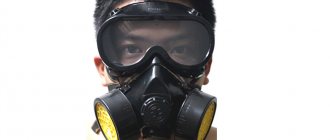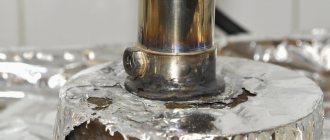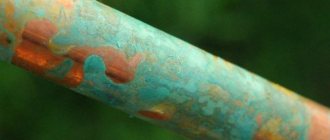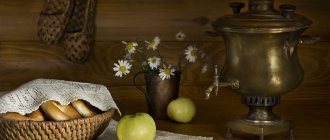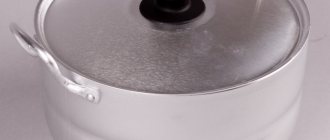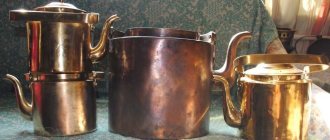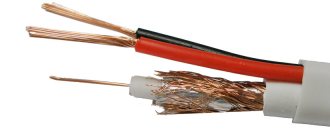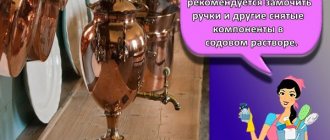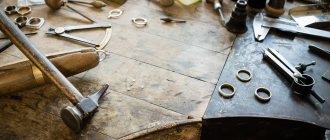How to clean copper oxide at home
Ketchup Dishwashing detergent Lemon juice “Vinegar dough” Bath of vinegar and salt Water and citric acid Paste based on chalk and ammonia Sulfamic acid A solution of oxalic acid, turpentine, citric acid and ethyl alcohol
How to clean copper coins yourself
9% vinegar 10% citric acid Ammonia or ammonium carbonate solution Ammonia
Copper products began to be produced back in the 4th-3rd millennium BC. The golden-pink colored metal was easier to mine than gold, silver and iron. At the same time, copper was then equal in value to precious metals. Copper received its Latin name - cuprum - in honor of the island of Cyprus. It was there that the richest copper deposits were located.
Source: Unsplash (@thecupandtheroad)
Before the development of technology, this metal was used only in the production of jewelry and added to other alloys, after which they began to make dishes and interior items from copper, because, unlike their iron counterparts, vases, plates, teapots and anything else made of copper are resistant to corrosion. Plus, copper also has disinfecting properties. For example, in Ayurveda (Indian traditional medicine), copper has been used since ancient times to sterilize water.
In general, copper products have many advantages, but in order for them to be useful and delight you with their pinkish glow, you need to clean them properly. Otherwise, oxidized copper utensils may become harmful to health.
Digestion
Cooking significantly speeds up the cleaning process. Typically a soda solution is used:
- Mix 1 tsp. soda and 100 ml of water.
- Bring the solution with the objects immersed in it to a boil.
- Hold the coins for about 5 minutes, then remove them with tweezers and evaluate the result. To do this, soak a piece of rag with vegetable oil and wipe the surface with it.
- If it doesn’t work the first time, you need to return the samples to the boiling solution and try again.
Advice: Practice on inexpensive items first, and then start cleaning more valuable ones.
What to do if the jewelry has already oxidized?
What to do if the jewelry darkens, despite all your tricks? You can wash it in a soapy solution, clean it with some food acid (for example, lemon juice or vinegar) or a solution of ammonia. If we are talking about uncoated jewelry, light abrasives such as tooth powder, soda slurry, or GOI paste are quite appropriate. You can also restore oxidized jewelry in a workshop. There, jewelry is cleaned with ultrasound in special cavitation baths. However, it must be taken into account that for this purpose the product sometimes has to be disassembled, which significantly affects the price of the service. So it’s better to store and wear your favorite jewelry correctly than to later pay money to have it professionally cleaned!
24.11.21
How to protect copper from corrosion
There are many products that can help reduce the likelihood of corrosion in various environments. Among them are:
- Changing the composition of the material . The use of alloying can significantly increase the level of corrosion resistance. In this case, the impurities may be different - the main thing is to take into account the area of use of the finished part and understand the potential risks in order to eliminate them.
- Tinning . The process involves treatment with liquid tin. An effective protective layer is created on the surface. Provided there are no defects, it will limit contact with the atmosphere and other factors leading to corrosion.
- Control over the area of use . When purchasing copper products, it is important to understand where you will be using them. It is necessary to protect the material from contact with sulfur and its compounds, and to prevent zinc or aluminum parts from being located nearby. They can provoke the appearance of electrochemical corrosion.
Taking into account the standard requirements for the use of copper products will significantly increase their service life and prevent problems with corrosion.
Return to articles Share article
Effective cleaning methods
Today, the arsenal of tools that can be used to clean copper has expanded significantly. Together with ancient vinegar, sand and wire sponges, a large number of both specially designed products and those adapted by folk craftsmen are used. Among the latter there are some quite unexpected ones.
How to clean copper
- Tomato ketchup. Apply a small amount of tasty seasoning to the stain and leave for several minutes. Rinse off with plenty of water.
- In case of light stains, you can try washing them with a regular gel detergent. The gel is squeezed onto a soft sponge and then applied to a copper object. After leaving for a minute, rub the surface and rinse with water.
- Used for large products, such as a samovar. Cut the lemon in half and rub the half over the surface of the product. Next, clean with an elastic fluffy brush and rinse with water.
- Vinegar dough. Mix vinegar and regular table flour in equal parts. Stir until a homogeneous paste-like mass is obtained. Next, the paste is spread in a thin layer on the surface to be cleaned. After waiting for complete drying, remove the product with a rag or wooden spatula. The product must then be polished with a soft cloth.
If the above methods do not lead to success, use the following method:
- Prepare a stainless steel basin or pan.
- Pour vinegar and add a couple of tablespoons of regular table salt. Stir thoroughly.
- Immerse the item to be cleaned in the solution and bring to a boil.
- Remove from heat and leave to cool at room temperature.
- Drain the cooled solution, rinse the copper object and wipe dry.
Cleaning copper with vinegar
If you decide to clean copper, take precautions. The use of protective gloves and glasses is mandatory. If you dilute vinegar essence, you should ensure ventilation of the room.
This is interesting: Brass LS59-1: characteristics and composition of the alloy, GOST
Precautions when cleaning copper
To preserve the health of people and material assets, you must strictly follow the safety rules:
- When working with chemically active substances, be sure to ensure ventilation of the room.
- Clothing and shoes should be tight and not leave any exposed skin.
- The use of protective gloves and glasses (face shield) is mandatory.
- Do not lean over containers with reagents, especially if a violent reaction occurs with the release of gaseous products and splashing.
- To avoid scratching the surface, do not clean copper products with hard wire brushes or rough abrasives.
- There is no need to keep objects in acidic solutions longer than necessary - in addition to the oxide layer, it is also possible to dissolve the product itself.
- Valuable figurines, coins and decorative items should be cleaned only with mild products. It would be a good idea to consult with experienced specialists.
Timely and regular care will allow you to maintain a beautiful appearance, true color and radiant shine for many years.
Reasons for oxidation of jewelry
The oxidation mechanism involves the introduction of oxygen molecules into the surface structure of the metal. Each metal reacts to this in its own way: it darkens, becomes covered with rust or patina.
Pure gold, silver and platinum group metals do not oxidize. But they are not used in their pure form to make jewelry: other metals - alloys - are added to them. The more alloys, the faster the jewelry alloys oxidize.
Jewelry alloys oxidize much more intensely than jewelry alloys. Metals containing iron are characterized by the appearance of a loose red layer - rust. But alloys that contain copper react differently to the penetration of oxygen: they darken and become covered with a bluish-green coating. This is a noble patina that can be seen on antique products made from copper and alloys containing it. Sometimes modern copper products (such as door handles or staircase elements) are deliberately patinated, giving them an antique appearance.
Jewelry specially coated with patina can be found on the websites of craftsmen. They are practically not produced commercially. As a rule, oxidation of jewelry is considered an unfavorable phenomenon that spoils its aesthetic appearance.
If jewelry oxidizes, you should try to bring it back to life or simply throw it away. Nothing spoils an outfit more than peeling or darkened jewelry!
Almost all jewelry alloys contain copper. This applies to both red and yellow (brass, bronze, tombac, randol) and white (nickel silver, nickel silver, alpaca and others like them) alloys. Therefore, the main “disease” of jewelry alloys is greening.
Silver earrings with ceramics and cubic zirconia (go to the SUNLIGHT catalogue)
Another metal that is added to most alloys is zinc. This metal, for example, is part of tombac, which is very similar to gold, which is often used by scammers. The zinc alloy in costume jewelry darkens, forming an unaesthetic coating, so that counterfeit jewelry inevitably reveals its ignoble origin over time.
High-quality jewelry is produced mainly from metals with a durable coating. The base is usually brass or another metal, and gold or silver is used as a coating. The thicker the precious coating, the better and more expensive the product.
There are a number of factors that help accelerate oxidation processes. This impact:
- high humidity and water (especially salty);
- temperature changes and heat;
- chemicals used in everyday life;
- cosmetics, hygiene products, perfume;
- natural body secretions.
It is impossible to completely protect your beloved jewelry from all these factors, but it is entirely within your power to minimize their harmful effects.
How to protect your jewelry?
To prevent jewelry from darkening or oxidizing, it should be worn and stored properly. Nowadays, popular trees and jewelry hangers are suitable only for temporary storage of jewelry. Dust settles on it, sunlight and other undesirable factors affect it.
Ideally, you should store your jewelry in a closed box, pencil case, organizer or cabinet, flattened. It is advisable to assign each piece of jewelry a separate compartment, and perfectionists store jewelry in personal bags and boxes. It’s good to put sachets of silica gel in the box, which removes moisture.
Silver pendant with amber (go to the SUNLIGHT catalogue)
It is virtually impossible to prevent jewelry from darkening at all, especially if it is made of “bare” alloys without coating. However, you can pause this process.
- Keep jewelry away from sources of heat and moisture, and protect from direct sunlight.
- Be sure to remove jewelry at night, during water procedures, physical labor and training.
- Apply creams and perfume first, and only then put on jewelry.
Take the time to coat the jewelry so that it does not oxidize so intensely. There are special varnishes for this, and some can cover not only metal (including fittings), but also stone, wood, glass, and so on.
The layer of varnish on the jewelry wears off over time. But it doesn’t matter: one bottle of good varnish will last you a very long time.
What is copper?
Copper is a ductile, but at the same time durable metal of a reddish-brown color. It is one of the main elements of the periodic table. The copper-based alloy is used to make other metals such as bronze and brass.
The scope of application of this metal is extremely wide. Due to its strength, it is in great demand in construction for the manufacture of wires, fittings, copper mesh, wires and other things. In the agricultural industry, copper is used as part of copper sulfate. Most wind musical instruments are made from copper. This metal is also widely used in the creation of plumbing pipes.
Despite the fact that copper is not a precious metal, it is also in demand in jewelry. You can find a lot of beautiful and very elegant copper jewelry: bracelets, crosses, chains, earrings, rings, etc. Also, to make gold jewelry more durable, an admixture of copper is used.
Products made from this metal can often be found in the kitchen. Due to its resistance to corrosion and good heat conductivity, copper is used to make a huge variety of kitchen utensils: , etc.
It would also not be superfluous to add that in the old days, along with gold and silver, copper was used to make coins, which the common people called copper coins . Many coins have survived to this day.
Unfortunately, in the absence of proper and timely care, copper objects can lose their original shine, become dirty and become cloudy. Let's talk about the main rules that must be followed when caring for copper products.
